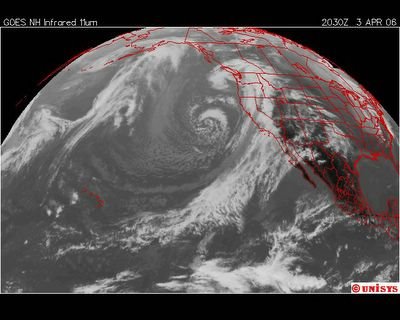
April 3, 2006. 2030z.
Infrared statellite. It's far scarier in water vapor resolution.
New Storm Moves Into Southland
Rain and winds are expected to batter the region, raising concern about floods, mudslides.
By J. Michael Kennedy, Times Staff Writer
April 4, 2006
A storm dipping south from the Gulf of Alaska is expected to bring Southern California three days of rain — some of it in heavy downpours — with the possibility of mudslides in recently burned areas.
But while the arrival of this latest storm was cause for concern in Southern California, the situation was more pressing in the northern part of the state, where much of the region remained under a flood alert. A month of nearly continuous rainfall has endangered the stability of levees and raised rivers to flood levels.
The Los Angeles-area rain was expected to increase from intermittent showers to steady rainfall early today and continue through Wednesday. The heaviest rainfall was expected in the San Gabriel Valley, where 5 or more inches could fall, said Bonnie Bartling, a specialist with the National Weather Service.
The storm system should drop 1 to 3 inches of rain along the coast and more than 3 inches in the mountains and foothills.
The storm should continue through Wednesday, with the heaviest precipitation probably coming today, Bartling said. She said there could be 4 to 7 inches of snow in the upper mountains today and in lower elevations overnight as the air cools.
Accumulations of up to 7 inches are expected at the 5,000-foot level by Wednesday morning. Winds between 20 and 30 mph are expected in the next two days.
Despite the expected rain, Laurel Canyon Boulevard in the Hollywood Hills was reopened Monday after being closed over the weekend when a rain-drenched hillside began to slide.
Crews installed concrete barriers Sunday to protect against mud and debris flows that could be brought on by rain.
Bartling said other areas of concern would include the areas of last year's Topanga, Foothill and Harvard fires. Because the burn areas lack ground cover, they are more prone to breaking up and becoming mudslides when soaked.
Sam Padilla, a spokesman for the Los Angeles County Fire Department, said all stations near the burn areas are equipped with sandbags if residents need them.
"They are keeping their eye on areas where the vegetation has been depleted and the ground is most vulnerable," he said.
Meanwhile, continuing deluges in Northern California kept roads closed and raised concerns about flooding and mudslides there. Major Northern California reservoirs were increasing releases in anticipation of runoff from mountain snowmelt as skies dump more rain on the saturated region.
The National Weather Service in Monterey said there appeared to be little chance of a return to dry weather for the foreseeable future. The state Department of Water Resources issued a flood alert, formally raising the agency's emergency level.
The Bay Area has endured record-breaking wet weather over the last month. San Francisco had 25 days of rain in March, breaking the previous record of 23 days set in 1904. Oakland, San Rafael and Santa Rosa also broke rainy-day records in March.
Late Sunday, the California Highway Patrol closed a section of Highway 1 between Pacifica and Montara after a portion dipped about a foot in the northbound lane, south of Pacifica.
http://www.latimes.com/news/printedition/california/la-me-rain4apr04,1,7877320.story?coll=la-headlines-pe-california
